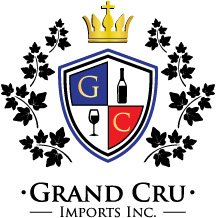An Introduction to Bordeaux's Grand Terroir
One of the many beautiful things about viticulture is that no two regions are the same. In fact, the difference between neighbouring vineyards can be staggering and Bordeaux is the perfect example of this.
During the last ice age, glaciers acted like giant bulldozers and picked up everything in their path while slowly inching across France. When that snowball melted, around 10,000 BC, everything that was picked up was released into a rushing river and deposited into the ground.
This outflow to the Atlantic provided Bordeaux with diverse "warm" and "cold" soils. Featuring gravel terraces interspersed with sand, silt, and clay, plus both fresh-water and salt-water limestones.
Gravel and Sand: The Warm Soils
As these soils warm with sun exposure, they radiate heat back up into the vine canopy and help to ripen the grapes by keeping the ambient temperature above the 10c minimum required for photosynthesis. This proves invaluable in the cool, but sunny evening hours of the late autumn and in the sunny, cool mornings of spring. Gravel yields wines with firm tannins, structure and aromatics. Sandy soil yields more opulent, soft and fruit-forward wine with easy drinkability.
Clay and Limestone: The Cold Soils
As these soils are both dense and moisture-retaining, they do not hasten the ripening process. Clay, much of which is iron-rich here, produces wines with notes of prune and walnut. Limestone produces wines with pronounced acidity and lean, polished tannins.
St-Émilion
A widely diverse appellation with several types of terroir, limestone is the one most associated with St-Émilion. These wines tend to be austere when young, with a wonderful saline finish and endless persistency.
Expect raspberry, cherry and blueberry, often with subtle oak influence. Yields are usually naturally low on limestone, giving concentration. Wines tend to be Merlot dominant, often blended with Cabernet Franc.
Château La Croix Bonneau
Saint-Émilion 2016
80% Merlot 20% Cabernet Sauvignon
$53.99 per bottle
92 points from Wine Enthusiast! This is a very well-structured wine that will age effortlessly. The colour is a deep and brilliant red. Small black fruits, chocolate and vanilla. The big nose opens with time to get more intense. Deliciously silky and balanced. Coated tannins and an intense and remarkable length. An elegant expression of what Bordeaux can do. Pair with dry-aged New York strip with roasted garden vegetables.
Pomerol
The vast majority of this region is a blend of gravel, clay and sand, with a dominance of powerful clay in the most prestigious vineyards like Petrus. It is a warm terroir, due to the location near the Isle river, and also the warming impact of gravel. The underpinning of clay gives power while maintaining freshness and plump, dense fruit character.
The wines tend to be concentrated and deeply coloured, with silky finessed tannins and good acidity. The dominant grape variety is Merlot. Look for black cherry, mocha, truffles, chocolate and violet.
Fugue de Nenin
Pomerol 2012
70% Merlot 30% Cabernet Franc
$104.99 per bottle.
Fugue de Nénin was created and first sold in 1997. Fugue comes from sandy-clay soils found in the eastern part of the Château's vineyards, as well as from the young vines planted on the great plateau terroirs. This second wine is a typical example of the charm of Pomerol. Fugue is a reference to music; it means a repetition of the main theme. This name makes sense when you taste the wine - Fugue complements the tonalities of its older sibling extremely well while providing its own attractive and entertaining rendition. The wines are smooth and silky and can be enjoyed earlier than those of the Grand Vin.
St-Julien
With a large proportion of gravel mixed with clay, this is the most consistent of all Médoc appellations.
Acidity tends to be relatively low compared to more clay-dominant wines, although always with a freshness on the finish thanks to the grapes and the location next to the Garonne Estuary.
Look for cassis, mint and eucalyptus, but more finely grained tannins than Pauillac, as a general rule. The wines are often understated but complex.
Château Moulin de la Rose
Saint-Julien 2014
65% Cabernet Sauvignon 35% Merlot
$83.99 per bottle
Half of the estate’s name is due to the former presence of a mill, and the other half linked with a knight named Chevalier Larose, who owned neighbouring great growth, Château Gruaud Larose in the 18th century. Delicate power and elegance. Give ample time to decant. Red and black fruits. Ripe, crispy tannins and a lovely, long finish. Pair with charred rib eye with broccolini and sauteed garlic.
Pauillac
Known as the "The land of gravel", a good amount of limestone and clay can be found throughout the appellation as well.
As a rule, gravel gives finesse, concentration and aromatics, but most of the soils of Pauillac have clay among the gravel, and one of the key characteristics is grippy tannins.
These give structure to the wines that give slow, long ageing, along with a freshness that shows in mint and eucalyptus notes on the finish. Look for pencil lead, slate, and concentrated black fruits that are most typically cassis and blackberry.
Les Tourelles de Longueville
Pauillac 2015
65% Merlot 20% Cabernet Sauvignon
10% Cabernet Franc 5% Petit Verdot
$99.99 per bottle
A very small selection of old vines from the Sainte Anne plot is designated to make Les Tourelles de Longueville, Pichon Baron's Merlot-based wine. This unique terroir gives a memorable and distinctive personality.
This vintage is full of charm and grace, suave and precise with a pleasing discreetness. The nose is marked by redcurrant, black cherry, wild strawberry and mild spices. The attack is fresh, elegant and subtle. The structure unfolds and grows in power. The finish is harmonious, full and well-balanced. Potential to age for 10-20 years.







